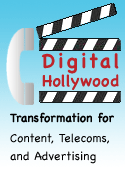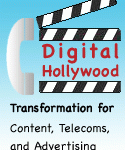Converged Experience Presages Telecoms Transformation—Reexamining the Value Proposition
 CTOs Chris Rice (AT&T), Pieter Poll (Qwest), Mark Wegleitner (Verizon) and Matt Bross (BT) agreed that the discrete services that telecoms now offer would morph into a seamless, hyperavailable cloud of communications services. The converged experience will be seamless, feature-rich and accessible when, how and where consumers want. Telecoms’ ability to deliver will drive their stock prices in the near term and was the focus of the discussion. CTOs Chris Rice (AT&T), Pieter Poll (Qwest), Mark Wegleitner (Verizon) and Matt Bross (BT) agreed that the discrete services that telecoms now offer would morph into a seamless, hyperavailable cloud of communications services. The converged experience will be seamless, feature-rich and accessible when, how and where consumers want. Telecoms’ ability to deliver will drive their stock prices in the near term and was the focus of the discussion.
From an operational perspective, telecoms have been too focused on product/service P&L. Now they have to eliminate barriers between products, so the customer can have a context-appropriate, seamless experience. The first phase of this transformation is bundling existing services; however, the real value will come from innovating new services. All applications will be unified around an IP (Internet Protocol) infrastructure. Telecoms don’t need to integrate networks; they need to build networks that interoperate.
Between the lines and longer term, telecoms must reexamine their value propositions because we are coming to the end of the era in which custom applications and proprietary interfaces were necessary to integrate networks’ “islands of automation.” Network-centric software […]
The Rise of the Niche Will Transform the Mass Model—The UGM Threat Is the Opportunity
 The advertising industry is at a crossroads. It came of age during the Industrial Economy, and explosive growth coincided with the development of the mass media and the focus on “brand” TV and print advertising. Big media and advertising reflect Industrial Economy values and sensibilities: produce big numbers efficiently and innovate when necessary. Amortize existing investments. The problem is, Knowledge Economy customers want to be communicated with as individuals. Since advertising’s processes have been built with big numbers in mind, they are expensive, and the numbers don’t work when agencies try to address niches. The advertising industry is at a crossroads. It came of age during the Industrial Economy, and explosive growth coincided with the development of the mass media and the focus on “brand” TV and print advertising. Big media and advertising reflect Industrial Economy values and sensibilities: produce big numbers efficiently and innovate when necessary. Amortize existing investments. The problem is, Knowledge Economy customers want to be communicated with as individuals. Since advertising’s processes have been built with big numbers in mind, they are expensive, and the numbers don’t work when agencies try to address niches.
Efficiency in advertising has given rise to a value chain that is as heavy with inflexible infrastructure as the airlines’ hub and spoke system. Advertisers remain focused on “reach,” the number of eyeballs that view their messages (and respond when it’s measurable). That’s how advertising effectiveness is measured. Advertisers are resistant to changing this system, and that makes emerging technologies like mobile video and social networks of secondary interest to them. Meanwhile, innovators are developing technology and offerings to […]
Content Providers Hobbled by Conventional Thinking—UGC May Fill Content Vacuum in Plum Mobile Video Market
 At Digital Hollywood Chicago, speakers held that video would grow significantly as a portion of content experienced on the three screens. However, no panelist gave a compelling reason that video would grow—and there are many problems that will dampen adoption in the short- to medium-term. I question whether they are just trying to drive demand to drive their businesses. Don’t forget that this conference is digital Hollywood. At Digital Hollywood Chicago, speakers held that video would grow significantly as a portion of content experienced on the three screens. However, no panelist gave a compelling reason that video would grow—and there are many problems that will dampen adoption in the short- to medium-term. I question whether they are just trying to drive demand to drive their businesses. Don’t forget that this conference is digital Hollywood.
Myopia is content owners’ biggest problem: they seek to repurpose existing content for the mobile screen to amortize past investments. This logic permeates their thinking and prevents innovation. Meanwhile, consumers are awakening to the excitement of consumer-produced content, the prices of software tools are falling, and skills are increasing. True, the production quality is usually amateurish, but UGC (user-generated content) is usually free, fresh and relevant—to niches, which is where the action is. Users produce content for fun, and they can afford to address topics that “professional” content cannot. Mass-produced vapid content will still have a place in the consumer entertainment universe, but it will decreasingly […]
But Legacy Thinking Makes Agency Ecosystem Vulnerable to Disruptive Change—Who Will Be Their Southwest?
 Technology is remaking the advertising business because it is beginning to enable individualized targeting via automated tools. It is not a moment too soon. Technology is remaking the advertising business because it is beginning to enable individualized targeting via automated tools. It is not a moment too soon.
The ultimate context for this session is that technologies are driving interactivity, which is becoming the default for marketing communications. Legacy players in the marcom value chain have mixed feelings: they want to leverage their investments in legacy processes, people and relationships, and many of their clients are not pushing for interactive or its latest incarnation, digital video.
Thought leaders and visionaries are frustrated by their colleagues’ reticence because they perceive that marketers’ worst fear—irrelevance—will soon ensue unless they begin to make serious investments in digital video and Web 2.0, which highlights peer-to-peer interactivity.
When it burst into public view with the growing popularity of the Internet (“Web 1.0”), “interactivity” represented new capabilities and sensibilities. Viewers of marcom messages could react to the messages by clicking, and these clicks could be tracked very economically.
 However, this was merely a brief overture […] However, this was merely a brief overture […]
Pervasive Consumer Connectivity Vision Upstaged by Enterprise Web 2.0 Collaboration
 Cisco’s John Chambers is a master technology marketer who quickens your pulse with technology fire and brimstone. However, as the long-time CEO of Cisco, which epitomized the rise of the (Silicon) Valley when it was briefly the most valuable company in the U.S. in 2000, he has seen the company through the tech bust and proven that he has substance and staying power. Although a hypemeister extraordinaire, he may have crystallized the promise of the Enterprise Web 2.0 better than any other speaker at Digital Hollywood Chicago. Cisco’s John Chambers is a master technology marketer who quickens your pulse with technology fire and brimstone. However, as the long-time CEO of Cisco, which epitomized the rise of the (Silicon) Valley when it was briefly the most valuable company in the U.S. in 2000, he has seen the company through the tech bust and proven that he has substance and staying power. Although a hypemeister extraordinaire, he may have crystallized the promise of the Enterprise Web 2.0 better than any other speaker at Digital Hollywood Chicago.
Chambers’ demos of whiz-bang consumer entertainment scenarios were intriguing but far less interesting to an enterprise-focused audience than his accounts of how Cisco had drastically increased its already-leading efficiency in mergers and acquisitions by collaborating with Web 2.0 tools like wikis. We anticipate that his consumer-focused vision will be consummated far in the future, but his message about enterprise collaboration is achievable this year—for those who are looking for it.
Chambers described an emerging future of networks and communication that revolved around pervasive video, […]
Consumer Mistrust Will Slow the Reality of Mobile Personalization Vision
 Panelists at Digital Hollywood Chicago constantly spoke about mobile as the most “personal” of the three screens—for several reasons. The phone number is individual, so all the device’s activity can be attributed to a person, whose preferences and needs can be deduced from the activity. In addition, the mobile (phone) accompanies the individual almost everywhere, so it offers a wide scope of visibility into his/her activities, location and interactions. Panelists at Digital Hollywood Chicago constantly spoke about mobile as the most “personal” of the three screens—for several reasons. The phone number is individual, so all the device’s activity can be attributed to a person, whose preferences and needs can be deduced from the activity. In addition, the mobile (phone) accompanies the individual almost everywhere, so it offers a wide scope of visibility into his/her activities, location and interactions.
The mobile device will soon lose the “phone” moniker because the device morphing into a portable digital hub. “Smartphones” have seen much slower adoption than hoped, but functionality, power and capability are steadily increasing while prices fall. Apple’s iPhone was constantly mentioned as the promising breakthrough device.
Mobile devices will change relationships far more than the first screen (TV) or the second screen (computer) because they will touch everyone, their capabilities will rival laptops’ within 2-3 years, and they are inherently social. Social networking via video sharing, Web browsing, email, SMS, IM, music sharing and voice calling is on tap in the latest smartphones. The problem is, their features […]
The Challenge of Consumer/Advertising Misalignment: How to Finance Free Content
 At Digital Hollywood Chicago, few disputed that broadcast TV and mass advertising’s golden age had passed and that several technologies and cultural shifts were pressuring senior marketers to change. To fully appreciate this challenge, one has to consider the three screens through which most consumers experience “content. ” What consumers do with the changing capabilities of each screen changes their expectations and behaviors about their experience with all three screens, dramatically increasing opportunities and threats. Interactivity is increasingly available for TV (video). Convergence among the three screens is another important thread. Younger generations of consumers have little tolerance for the concept of mass advertising. At Digital Hollywood Chicago, few disputed that broadcast TV and mass advertising’s golden age had passed and that several technologies and cultural shifts were pressuring senior marketers to change. To fully appreciate this challenge, one has to consider the three screens through which most consumers experience “content. ” What consumers do with the changing capabilities of each screen changes their expectations and behaviors about their experience with all three screens, dramatically increasing opportunities and threats. Interactivity is increasingly available for TV (video). Convergence among the three screens is another important thread. Younger generations of consumers have little tolerance for the concept of mass advertising.
The most rapacious symptom of the weakness of the mass broadcast advertising model is the widespread adoption of the PVR (personal video recorder), which enables (home) viewers to record TV programs—and to skip advertisements. A couple of eye-opening facts: 1) on average, TV programming contains 8.5 minutes of advertisements during each 30 minute segment of programming and 2) 70% of adverts are fast-forwarded through or eliminated. And these numbers pertain to (mostly) non-digital (analog) […]
Mobile Video: A Perfect Storm for User-Generated Content?
 At Digital Hollywood Chicago, mobile was constantly heralded as the emerging “third screen” because it would enable content consumption regardless of time or place, and most speakers posited that video would grow significantly as a portion of all content. However, there is little video content available for mobile viewing, so why should consumers get excited about it? Will mobile shine as the most personal view into the consumer, or will it turn out to be the third wheel? At Digital Hollywood Chicago, mobile was constantly heralded as the emerging “third screen” because it would enable content consumption regardless of time or place, and most speakers posited that video would grow significantly as a portion of all content. However, there is little video content available for mobile viewing, so why should consumers get excited about it? Will mobile shine as the most personal view into the consumer, or will it turn out to be the third wheel?
All mobile value chain players are frenetically trying to build a new digital world around the mobile device, and this world will be comprised of the familiar triad: devices, networks and content, much of which will be video. Currently, video is the highest value content medium. This session examined the current stage of development to technology and business models.
Internet pioneers who remember the thrill of squealing modems connecting in the early days have a useful metaphor with which to regard video on mobile. We are very much in the early days: networks in most geos are inconsistent, and their ability to […]
Now Everyone Is a Producer—How Will User-Generated Content Affect Traditional Media?
 User-generated media (UGM) represents a poignant dichotomy within the context of Digital Hollywood Chicago: panelists and speakers represented a full spectrum of players that provide the capability for people to communicate, work and entertain themselves, but they have in common that they represent business interests. These players are in the business of commercializing communication. Consumers (aka “users,” “people”) represent personal interests: they communicate because they want to; they have little commercial interest in most of their communication. User-generated media (UGM) represents a poignant dichotomy within the context of Digital Hollywood Chicago: panelists and speakers represented a full spectrum of players that provide the capability for people to communicate, work and entertain themselves, but they have in common that they represent business interests. These players are in the business of commercializing communication. Consumers (aka “users,” “people”) represent personal interests: they communicate because they want to; they have little commercial interest in most of their communication.
Panelists grappled with this reality but did not address it directly. They explored business models for UGM—and mostly came up empty. The problem that UGM poses to providers is two-fold: UGM costs providers money in terms of bandwidth and other resources. It also carries a considerable opportunity cost, which is hard to measure but palpable: it crowds out commercial content by occupying customers in two ways: creating UGM and experiencing others’ UGM.
UGM is also difficult to compete against because its producers play by much different rules: they usually produce for free, while commercial producers have high costs. UGM producers […]
Redefining the Industry to Remain Relevant—The Significance of AT&T’s Big Bet on Mobile
 At Digital Hollywood Chicago, AT&T was busy redefining itself as a 21st century communications provider, and we believe that will increasingly mean focusing on content to provide profits. An AT&T veteran but new in 2007 as CEO, Randall Stephenson keynoted the conference by sharing his vision for AT&T and the future of the industry. At Digital Hollywood Chicago, AT&T was busy redefining itself as a 21st century communications provider, and we believe that will increasingly mean focusing on content to provide profits. An AT&T veteran but new in 2007 as CEO, Randall Stephenson keynoted the conference by sharing his vision for AT&T and the future of the industry.
Telecoms provide the network infrastructure of distributed computing and global communications, but infrastructure is a tough business with thin margins and high capital requirements. All telecoms are trying to move up the value chain to escape commoditization pressure and relentless price competition. For example, Sprint is betting heavily on WiMAX to redefine itself as the enabler of digital relationships.
In the context of telecoms redefinition, AT&T’s alliance with Apple could be very strategic for each company, as AT&T can use Apple’s design excellence to increase subscribers and push advanced network services while Apple needs a telecom partner to drive its relevance in the growing third screen market with the iPhone. According to Stephenson, the […]
|
|
 CTOs Chris Rice (AT&T), Pieter Poll (Qwest), Mark Wegleitner (Verizon) and Matt Bross (BT) agreed that the discrete services that telecoms now offer would morph into a seamless, hyperavailable cloud of communications services. The converged experience will be seamless, feature-rich and accessible when, how and where consumers want. Telecoms’ ability to deliver will drive their stock prices in the near term and was the focus of the discussion.
CTOs Chris Rice (AT&T), Pieter Poll (Qwest), Mark Wegleitner (Verizon) and Matt Bross (BT) agreed that the discrete services that telecoms now offer would morph into a seamless, hyperavailable cloud of communications services. The converged experience will be seamless, feature-rich and accessible when, how and where consumers want. Telecoms’ ability to deliver will drive their stock prices in the near term and was the focus of the discussion.
 However, this was merely a brief overture […]
However, this was merely a brief overture […] Cisco’s John Chambers is a master technology marketer who quickens your pulse with technology fire and brimstone. However, as the long-time CEO of Cisco, which epitomized the rise of the (Silicon) Valley when it was briefly the most valuable company in the U.S. in 2000, he has seen the company through the tech bust and proven that he has substance and staying power. Although a hypemeister extraordinaire, he may have crystallized the promise of the Enterprise Web 2.0 better than any other speaker at Digital Hollywood Chicago.
Cisco’s John Chambers is a master technology marketer who quickens your pulse with technology fire and brimstone. However, as the long-time CEO of Cisco, which epitomized the rise of the (Silicon) Valley when it was briefly the most valuable company in the U.S. in 2000, he has seen the company through the tech bust and proven that he has substance and staying power. Although a hypemeister extraordinaire, he may have crystallized the promise of the Enterprise Web 2.0 better than any other speaker at Digital Hollywood Chicago. At Digital Hollywood Chicago, mobile was constantly heralded as the emerging “third screen” because it would enable content consumption regardless of time or place, and most speakers posited that video would grow significantly as a portion of all content. However, there is little video content available for mobile viewing, so why should consumers get excited about it? Will mobile shine as the most personal view into the consumer, or will it turn out to be the third wheel?
At Digital Hollywood Chicago, mobile was constantly heralded as the emerging “third screen” because it would enable content consumption regardless of time or place, and most speakers posited that video would grow significantly as a portion of all content. However, there is little video content available for mobile viewing, so why should consumers get excited about it? Will mobile shine as the most personal view into the consumer, or will it turn out to be the third wheel? At Digital Hollywood Chicago, AT&T was busy redefining itself as a 21st century communications provider, and we believe that will increasingly mean focusing on content to provide profits. An AT&T veteran but new in 2007 as CEO, Randall Stephenson keynoted the conference by sharing his vision for AT&T and the future of the industry.
At Digital Hollywood Chicago, AT&T was busy redefining itself as a 21st century communications provider, and we believe that will increasingly mean focusing on content to provide profits. An AT&T veteran but new in 2007 as CEO, Randall Stephenson keynoted the conference by sharing his vision for AT&T and the future of the industry.